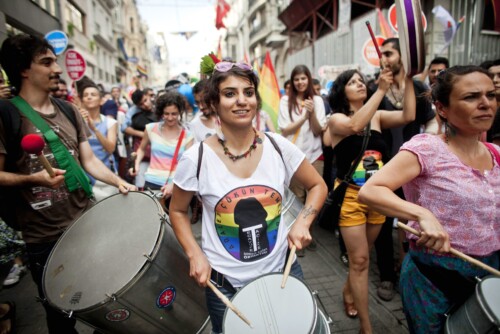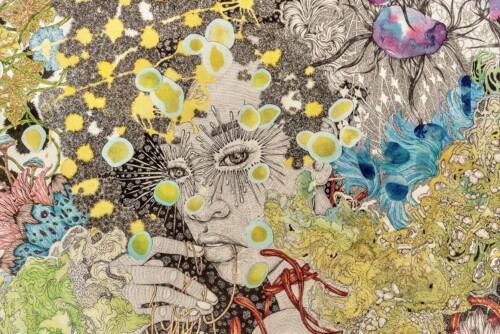Emphasizing Mutuality
Rather than denying importations from the West or engaging in the futile exercise of trying to invent entirely indigenous terms, categories and forms of activism, we should acknowledge our inevitable hybridity as a strength, and should also foreground the generally unacknowledged Indian influences on Western ways of thinking about sexuality. For example, the Kamasutra became widely known in the West from the late nineteenth century onwards.
But it is not as widely known that the Kamasutra is a sacred text; it is not just a sex manual. It is named for Kama, the God of love, and kama or desire is one of the four classical Hindu aims of life (the other three are dharma, artha or wealth, and moksha or liberation). Most popular editions of the Kamasutra today omit Chapter 9, which deals with the “third nature,” defined as men who desire men. After an extended description of oral sex between men, which is compared to sucking a mango, an experience with which most Indians are familiar, the chapter also refers to men who are not of the “third nature” but who may nevertheless engage in amorous relations with close friends whom they trust. The text thus leaves open the possibilities both of categorization and of flexible sexuality that is not categorized.1
Many modern Indians are embarrassed by the Kamasutra; an early twentieth-century Hindi translator claimed that the Kamasutrawas written to warn people away from such acts, and a recent article in the right wing Hindu magazine Organiser says the Kamasutra was written to provide variety and entertainment to heterosexual couples (he obviously doesn’t know that the text also has advice for homosexual couples, adulterous couples and courtesans).2 However, other commentators in rightwing forums disagree, and support decriminalization.3 Readers of all these articles conduct a vigorous debate online, by no means all taking the same position.
Instead of trying to reduce the influence of one culture on another, I suggest that we try to expand mutual influence with the emphasis on “mutual.” There is at present a great imbalance of knowledge because, despite many stereotypes and misconceptions, educated people in India know generally more about the US than educated Americans know about India. In order to redress the balance, I suggest that each individual take it on him or herself to become educated about the culture, religions and history of one other country. By this I do not mean a do-good approach, flitting from one continent to another. I mean a patient, in-depth self-education over years, such as that undertaken by many remarkable individuals, for example, Frenchman Francis Warcziag, who with his Indian partner Aman Nath, restored numerous neglected Indian buildings, and lived for over four decades in India.
Likewise, rejecting widely understood English-language terms is neither possible nor desirable. We do not feel any angst about using words like child, family, religion or even sex in Indian contexts although the Indian-language equivalents are often divergent in meaning. Why then the special angst about terms like gay and lesbian, which are widely used in India – they even occur in Indian-language texts in the 1960s. English is an Indian language, spoken, written and read in India for 200 years, and India is now the world’s second largest English speaking country, with about 125 million speakers. All Indian languages have picked up many English words, and this practice dates back to the late eighteenth century, at which time Urdu poets used words like “bottle,” “powder” and “lady.”
Furthermore, English-language terms themselves are hybrid. For example, the term lesbian acquired its modern meaning with reference to Sappho of Lesbos. It was only in the nineteenth century that Greece was redefined as definitely part of Europe. Before that, Greece’s position was ambiguous, somewhat like that of Russia today. Europeans traced their cultural heritage to Greece, but Greece had also been the center of the Eastern Church (as distinct from Rome, center of the Western Church), and large parts of Greece were considered part of Asia Minor. So the word “lesbian” could be seen as a reference to an Asian woman.
It is also important to note that while intellectuals agonize about politically correct language, antigay groups have no compunctions about using the most familiar terms. Evangelical missionaries from the US actively campaign against gay people in India. While not as successful as they have been in Africa, they are making inroads. As early as 2000, Peter Lane of Exodus International spoke at several forums in Bangalore, and was challenged by many young people from the Bangalore Law School. Writing in the newsletter of Respect for Life India (RELIEF), reporter Maya Philip remarked, “Gay rights activists had succeeded in their propaganda in making homosexuality acceptable to these young people.”4 Among the gay rights activists she refers to were young lawyers and scholars who founded Alternative Law Forum in Bangalore, a vibrant space for discussing and working on Constitutional and political issues, including sexuality rights.
Although Christianity is said to have come to India in the first century AD much before it reached most of Europe, there is no doubt that modern Indian Christians are influenced, for better or for worse, by Christianity in the West. In January 2014, some Christians held rallies supporting the anti-sodomy law in Chennai. Other Christian groups formed a rainbow coalition to contest this position.
Drawing categorical boundaries between countries and between categories is becoming an increasingly pointless endeavor, given the way the internet works, and more important, the growing numbers of biracial people, and people who hold dual or triple citizenships and live in more than one country. I have already given the example of Shobhna Kumar; another example is scholar Lawrence Liang, a founder of Alternative Law Forum, who is of Chinese origin and grew up in Bangalore.
Similar Goals, Different Paths
My last suggestion, the importance of allowing local activists to take the lead and shape the agenda, is related to the fact that change does not have to follow the same trajectory in every country. To borrow Hindu metaphors, although the aim of climbing up a mountain may be to reach the top, there are many paths to get there, just as all the rivers follow different courses to reach the same ocean. Acceptance of same-sex relations does not always have to precede acceptance of trans identity or gender-change. It could happen the other way round, as seems to be the case in some Asian countries, including India, where the Supreme Court in a 2014 judgment, recognized transgender people as a separate gender and directed the government to accommodate them accordingly.
Yet if change happens to follow the same trajectory, there is no need to be defensive about this either. For example, take the question of coming out. Some Indian gay people argue that coming out is not really necessary because Indians have different ways of communicating from Westerners. We don’t talk about everything, some say, but if we simply live our lives without hiding, that is enough; we don’t have to make a statement. However, in the aftermath of the Supreme Court reinstatement of the anti-sodomy law, one friend who had taken this position came out on TV and another friend told me that he now thinks the more people, especially celebrities, who come out the better.
Let me conclude with another Hindu metaphor, this time a visual one. Like the Kamasutra the sculptural friezes on the tenth-century temples at Khajuraho in central India are widely known for their erotic content, both hetero and homerotic, which are widely reproduced in print and online in tight, close-up frames. Opponents of laws like Section 377 point to them to argue that same-sex relations are accepted in Indian tradition while opponents tend to be embarrassed by such pictures.
However, I think this kind of focus does something of an injustice to the friezes by tearing them out of their context. When viewed in context, they are scattered among thousands of friezes that cover over a score of temples in the complex. The friezes depict life in all its variety – animals, plants, people, Gods, otherworldly beings, engaged in all kinds of activities, from war to music-making. The temples represent the universe in its vigorous beauty, and to narrowly focus just on one set of acts, whether to denigrate them or celebrate them, is to miss the larger whole. I think we need to re-emphasize that larger whole and all the ever-changing connections that mortals have throughout the world.
- For a detailed analysis and the debate about whether a verse in this chapter refers to male-male marriage, see Ruth Vanita, Love’s Rite: Same-Sex Marriage in India and the West (New York: Palgrave-Macmillan, 2005). [↩]
- Anandshankar Pandya, “Why Article 377 be Preserved,” Organiser. http://organiser.org/Encyc/2014/2/1/Why-Article-377-be-preserved.aspx, accessed 16 November 2015. [↩]
- Neha Srivastava, “Section 377 has Nothing to do with Indian Culture,” Swarajya, March 30, 2015, http://swarajyamag.com/culture/sec-377-has-nothing-to-do-with-indian-culture/, S. Venkataraman and H. Voruganti, “A Hindu Approach to LGBT Rights,” Swarajya, July 4, 2015, http://swarajyamag.com/culture/a-hindu-approach-to-lgbt-rights/. [↩]
- RELIEF, September-October 2000, p. 5. [↩]




